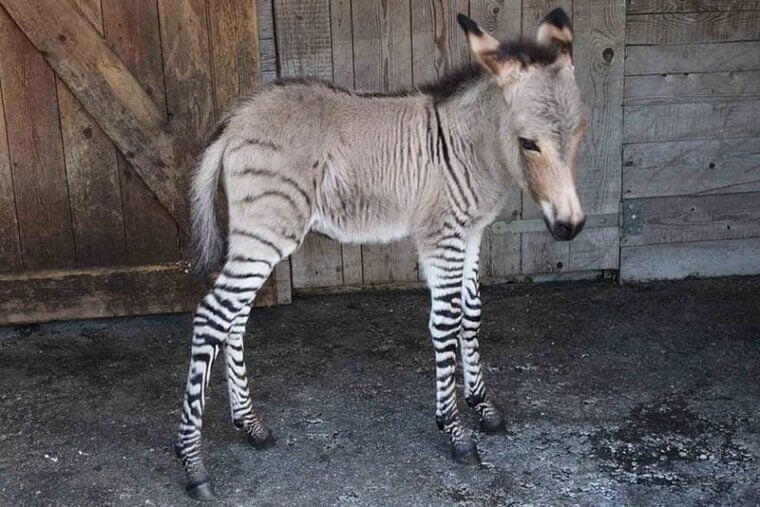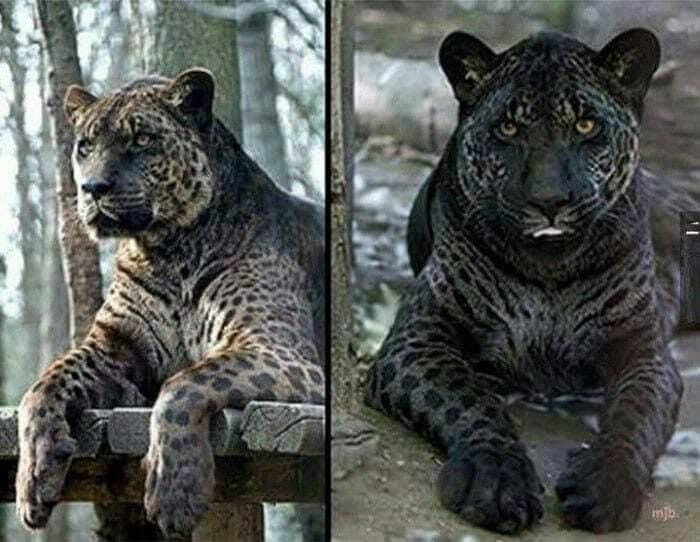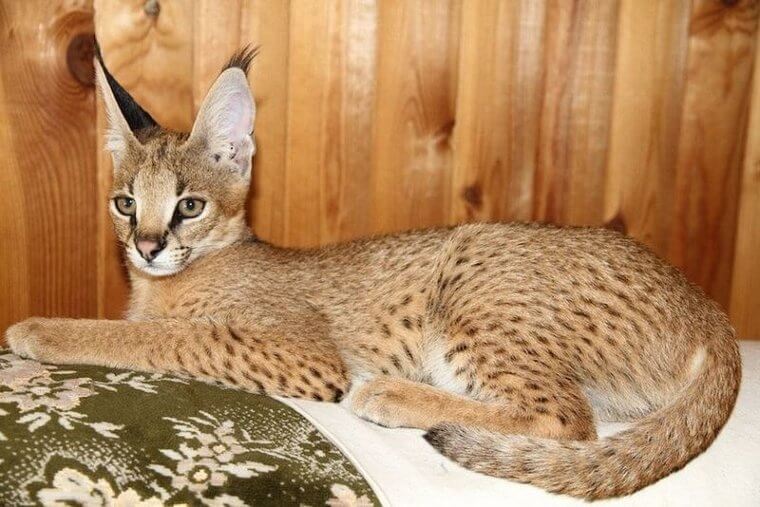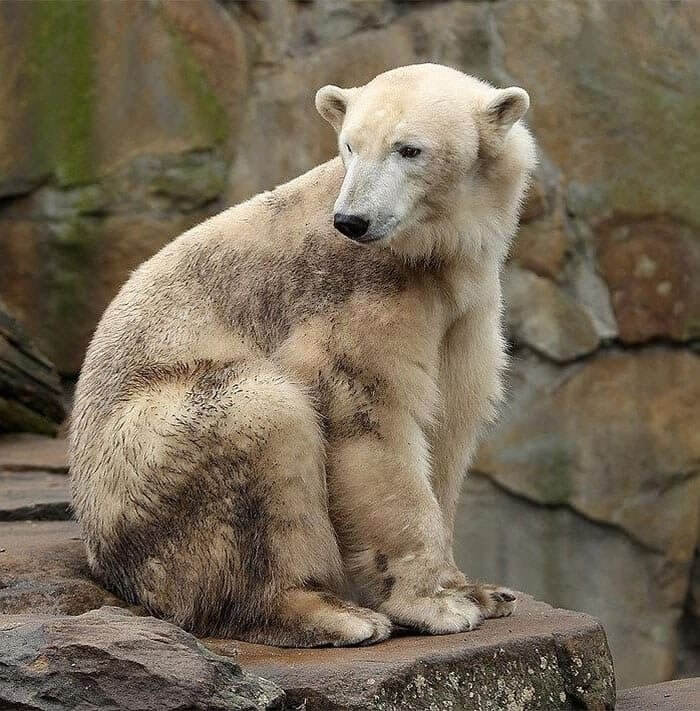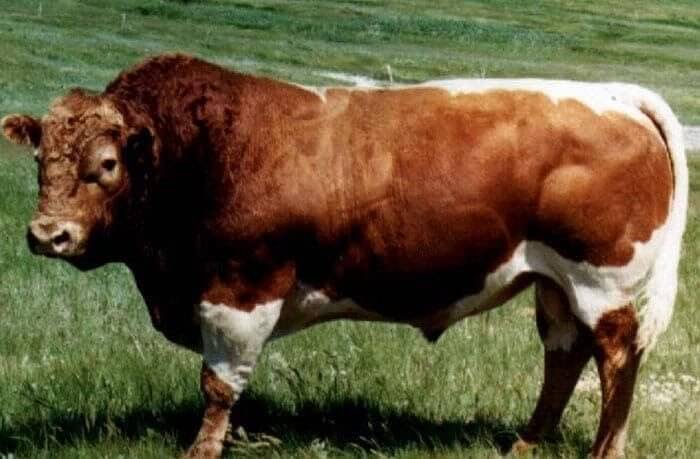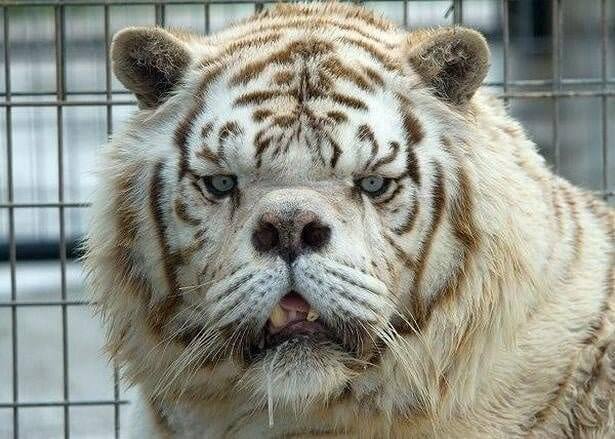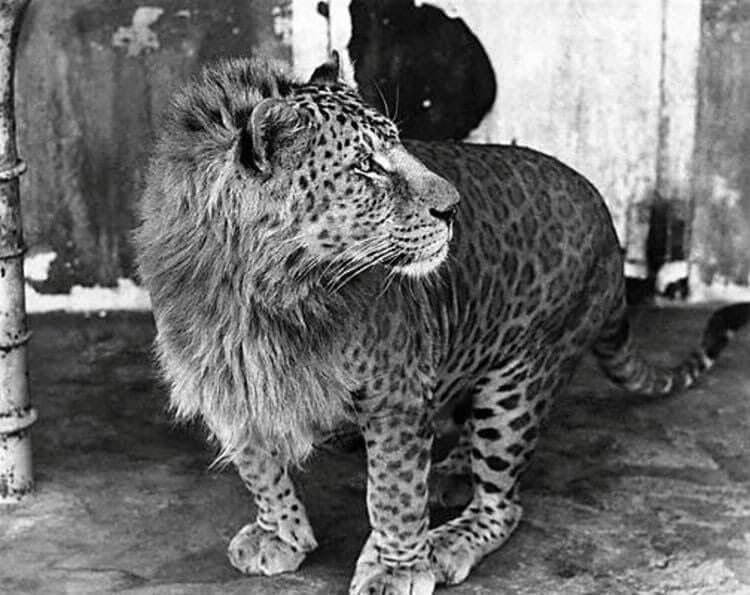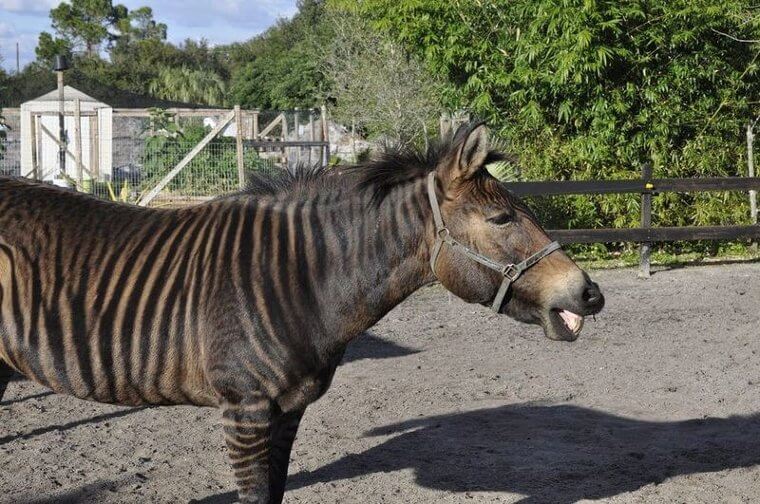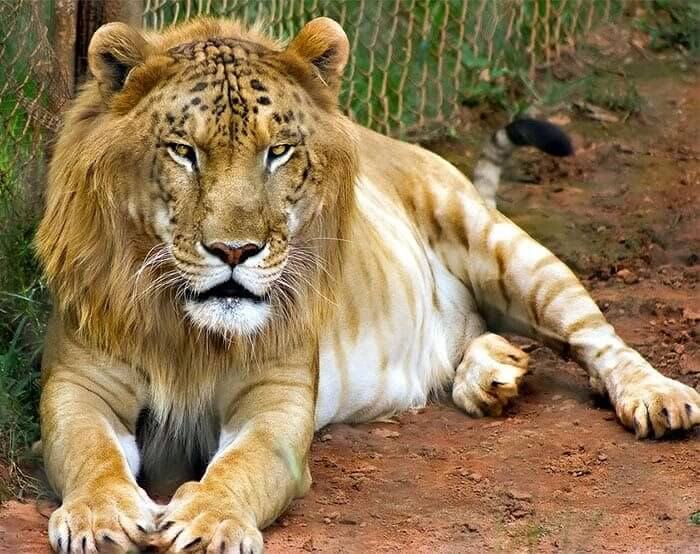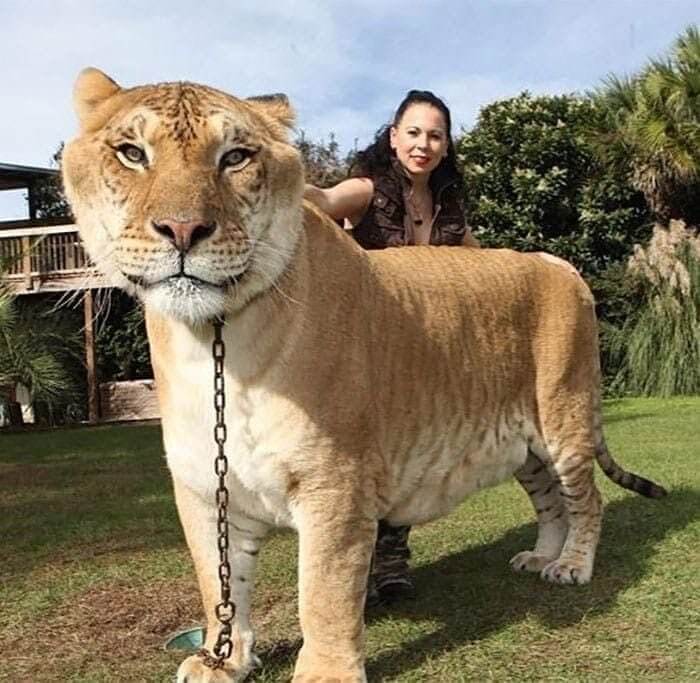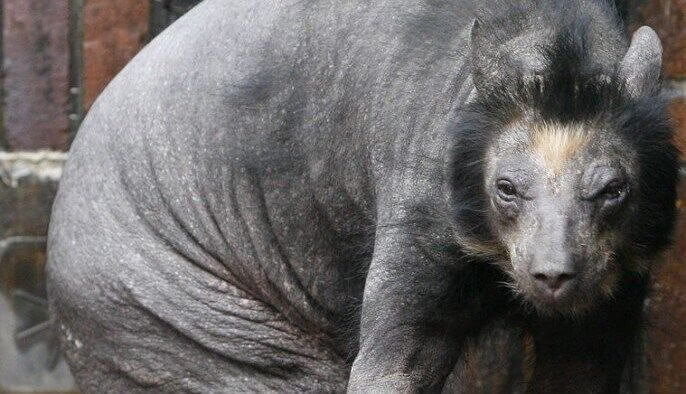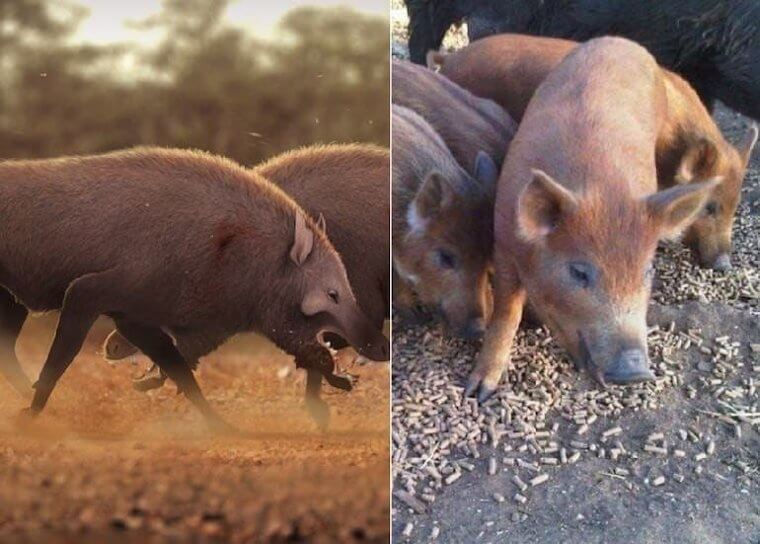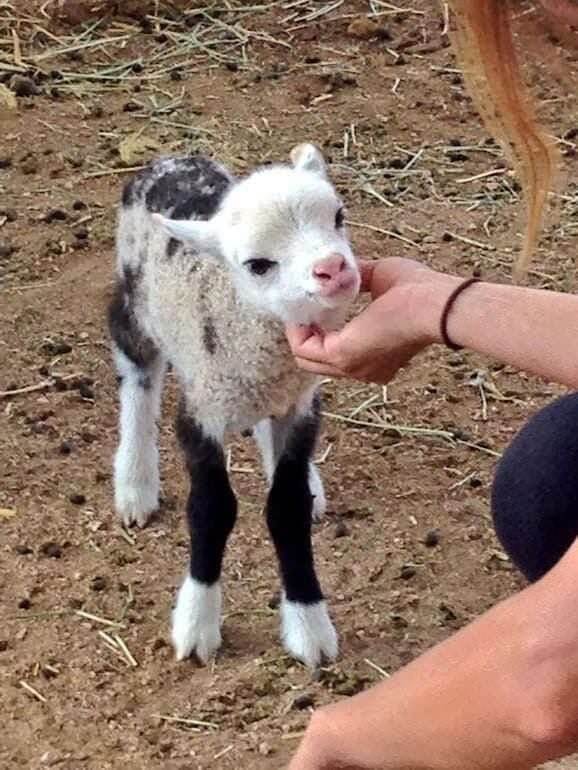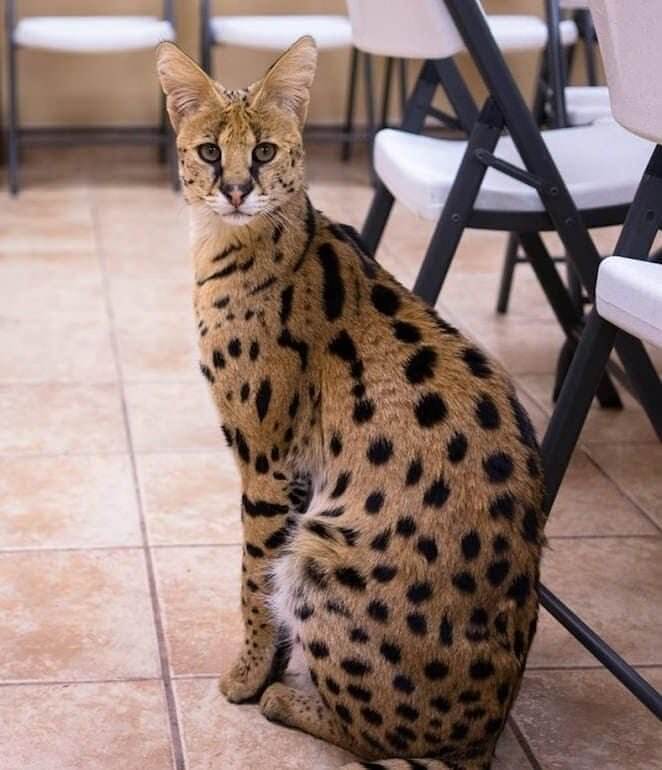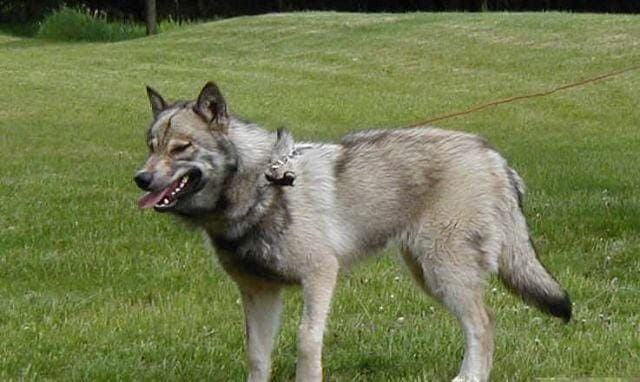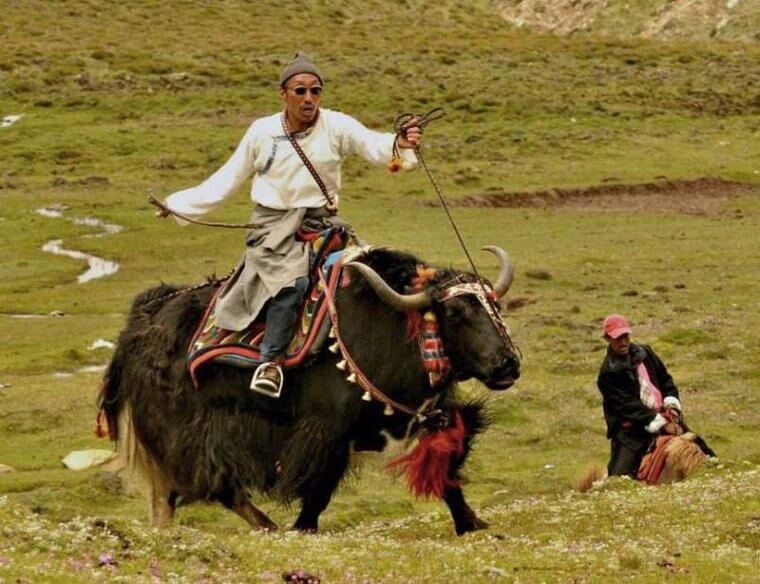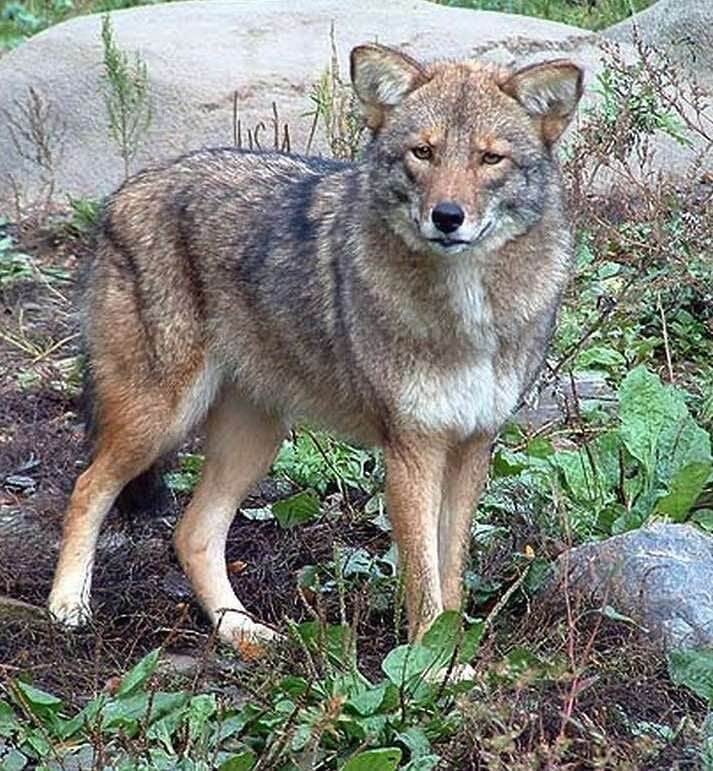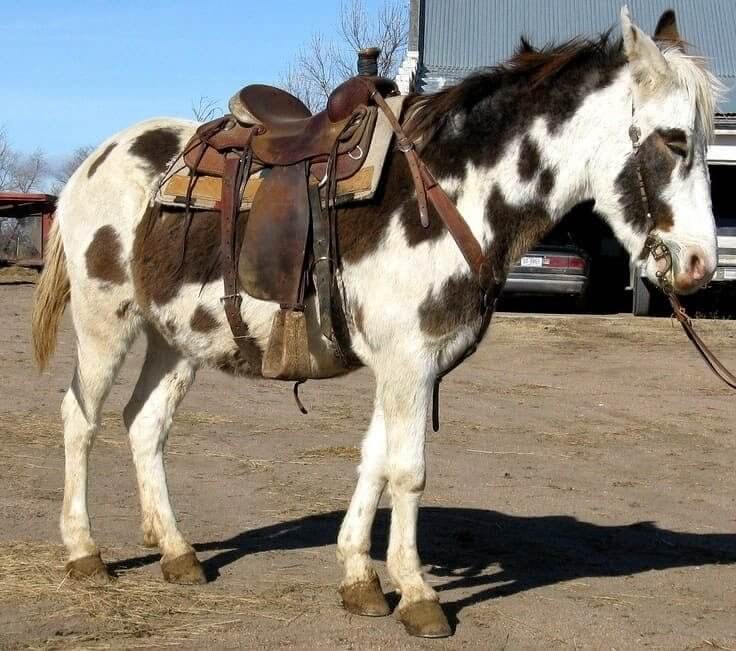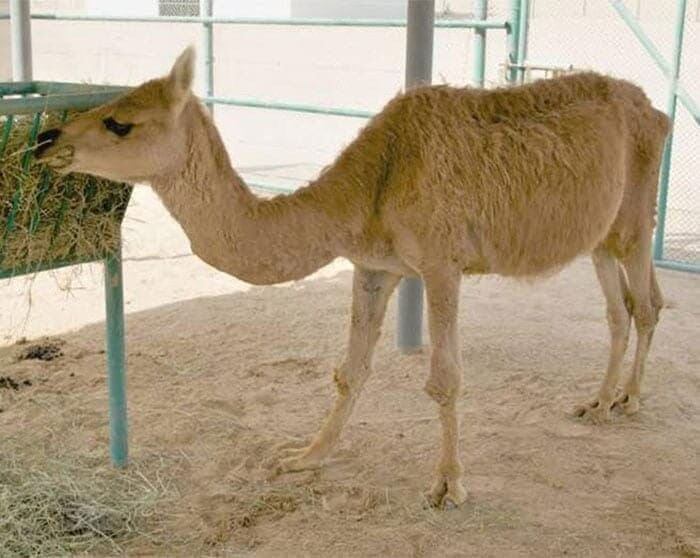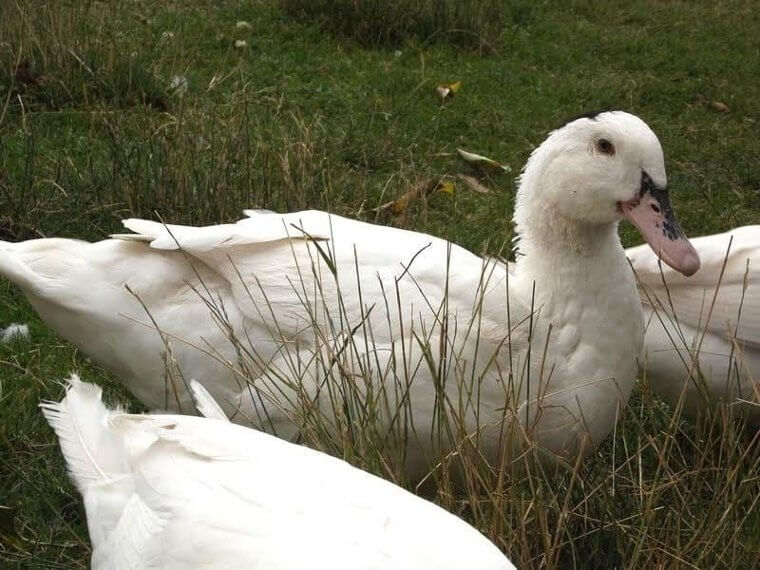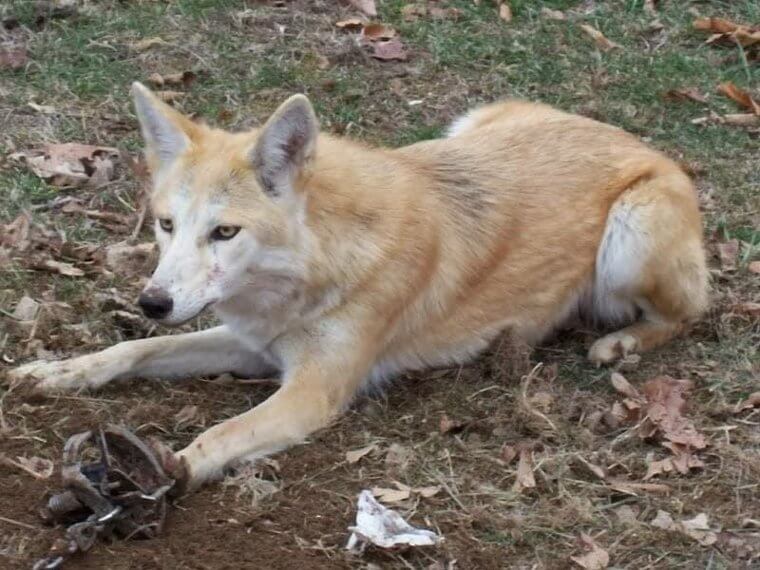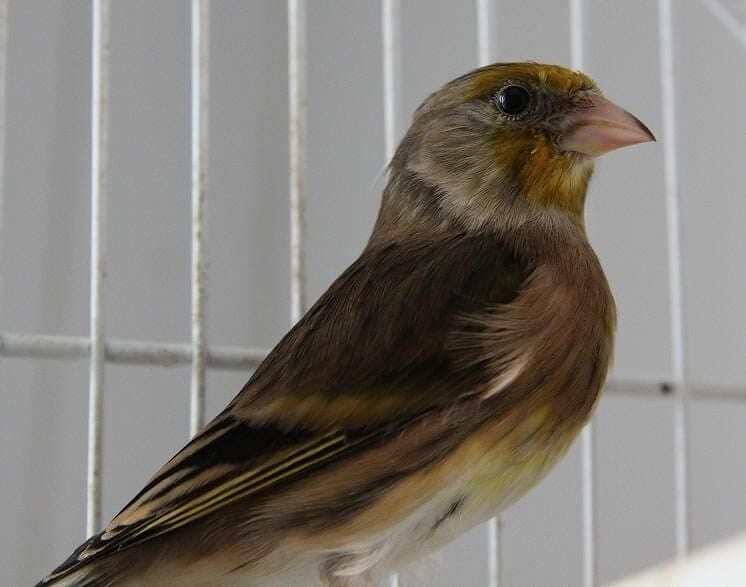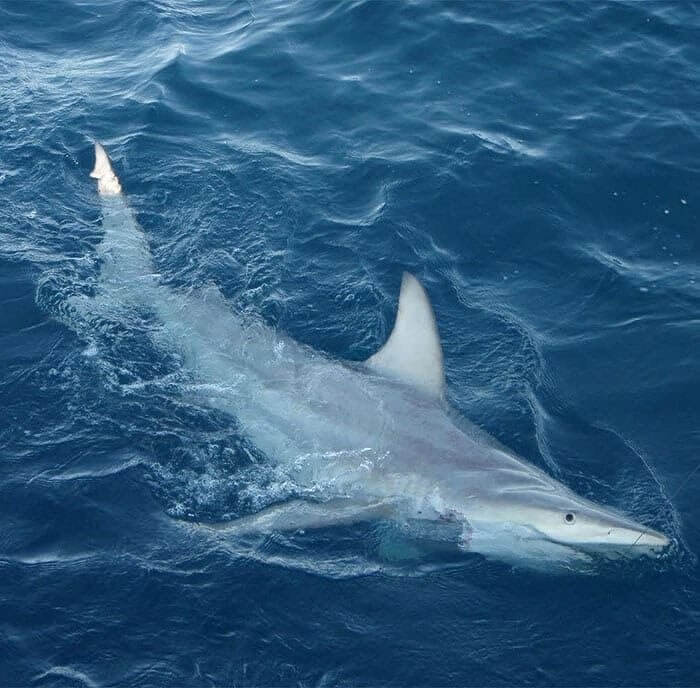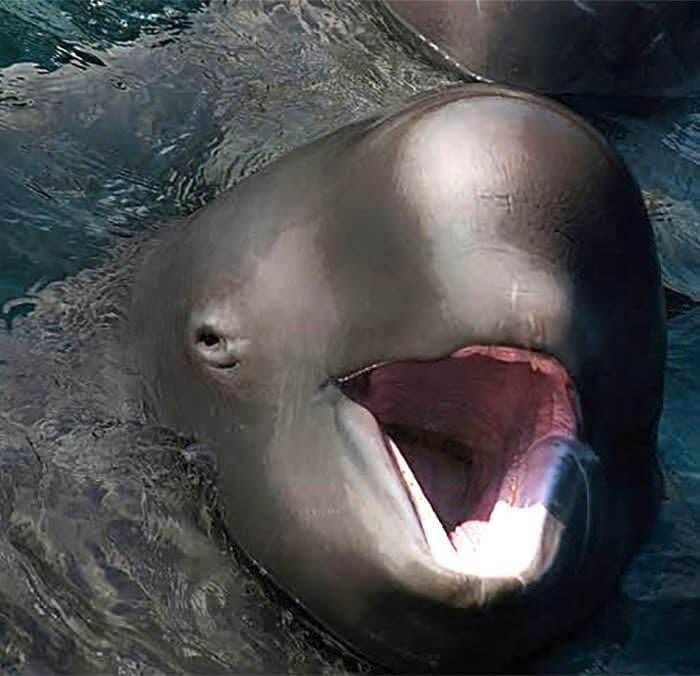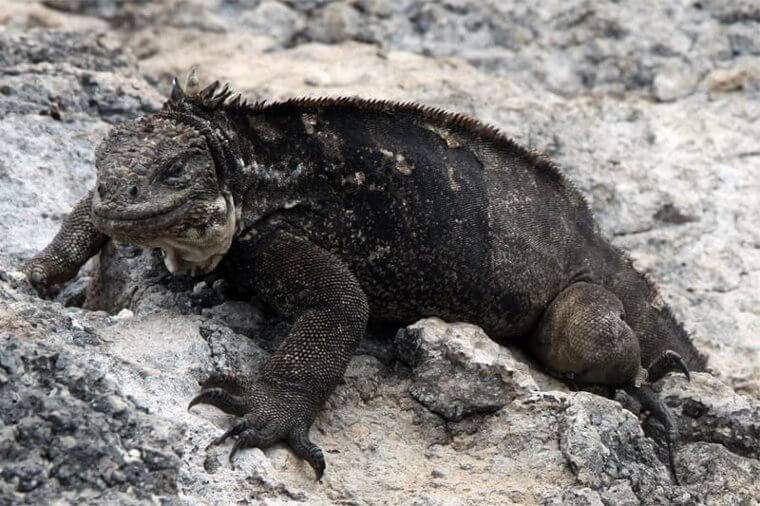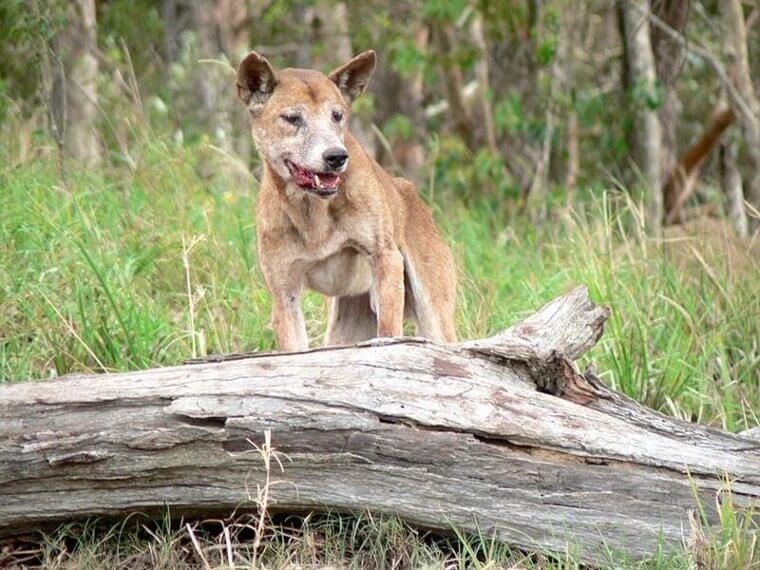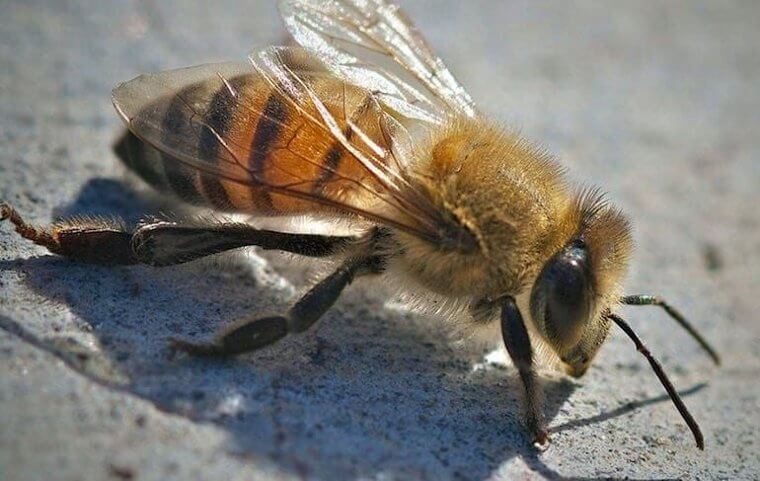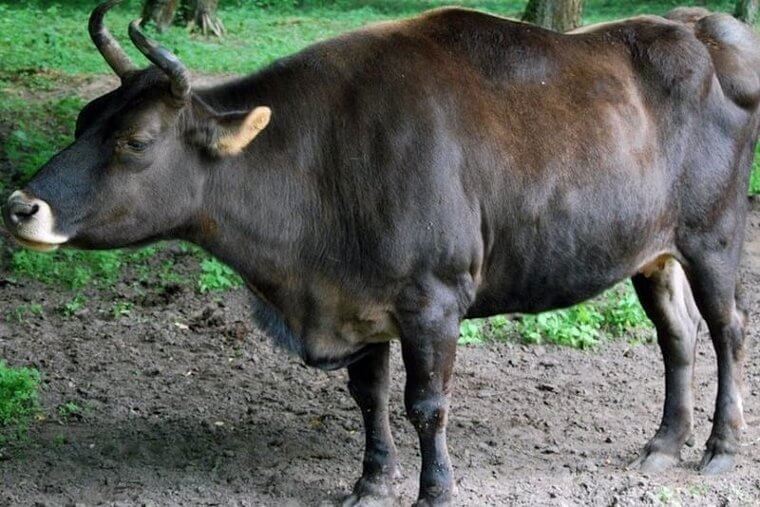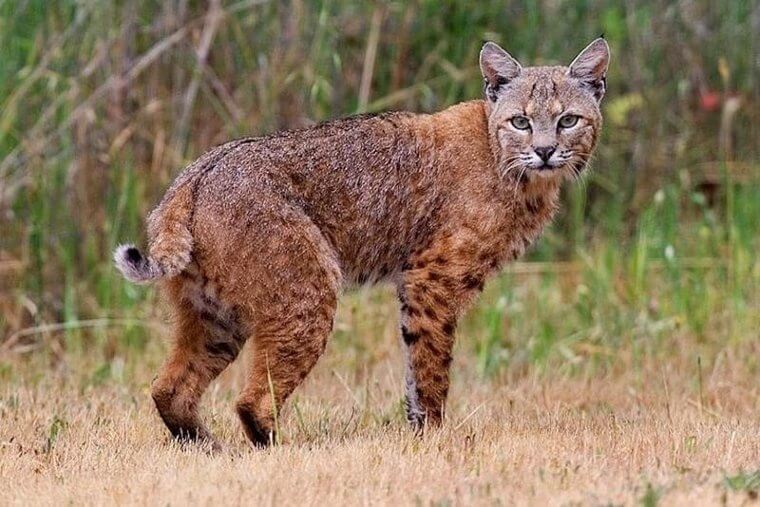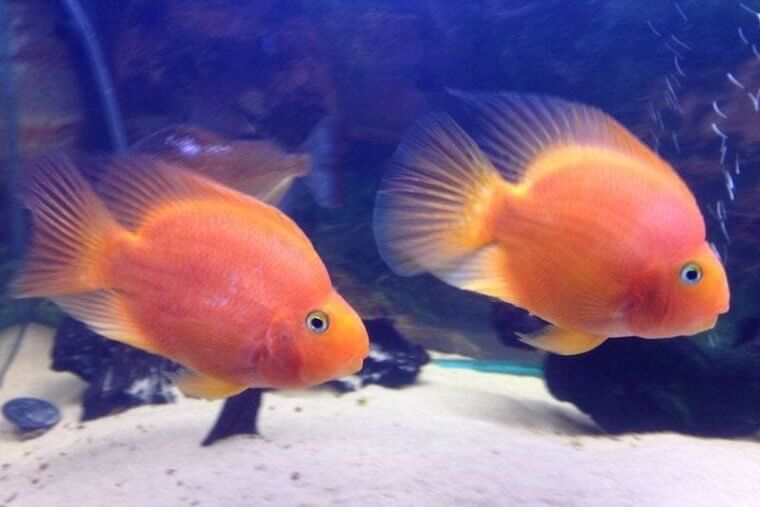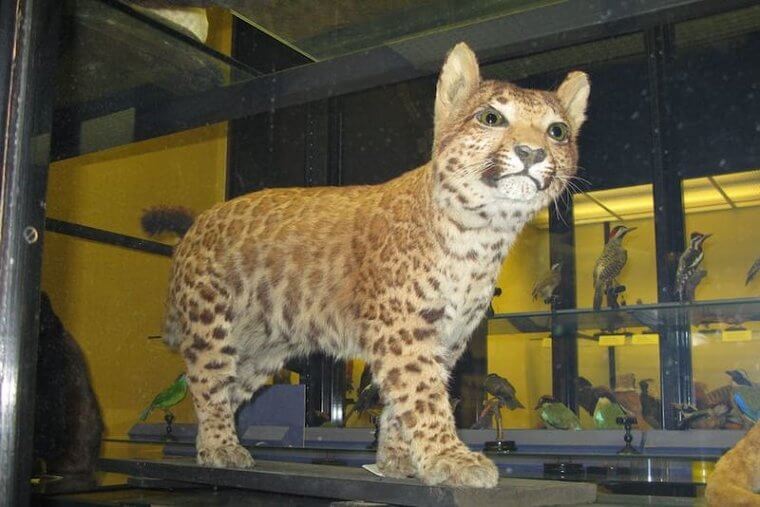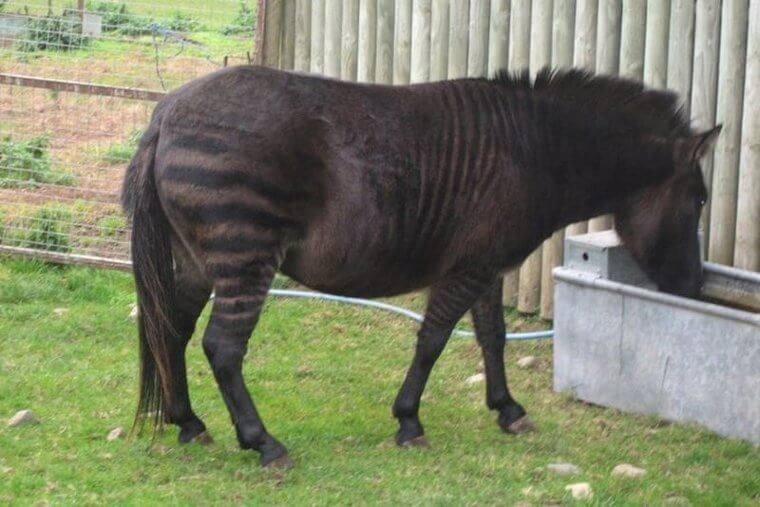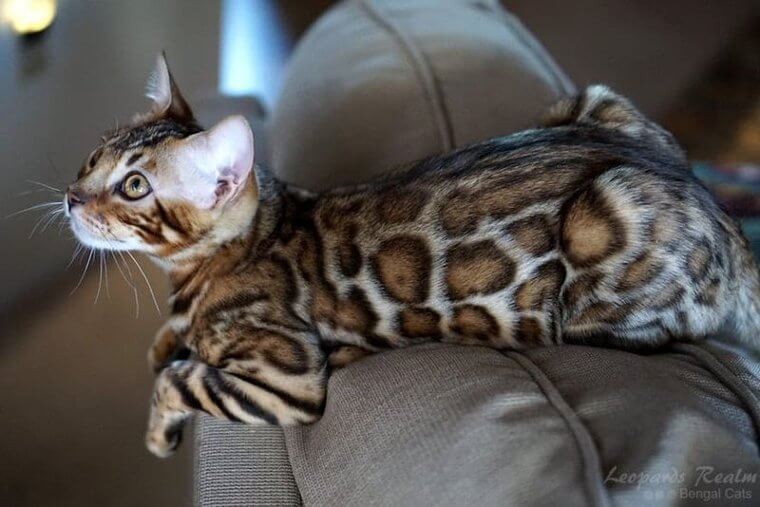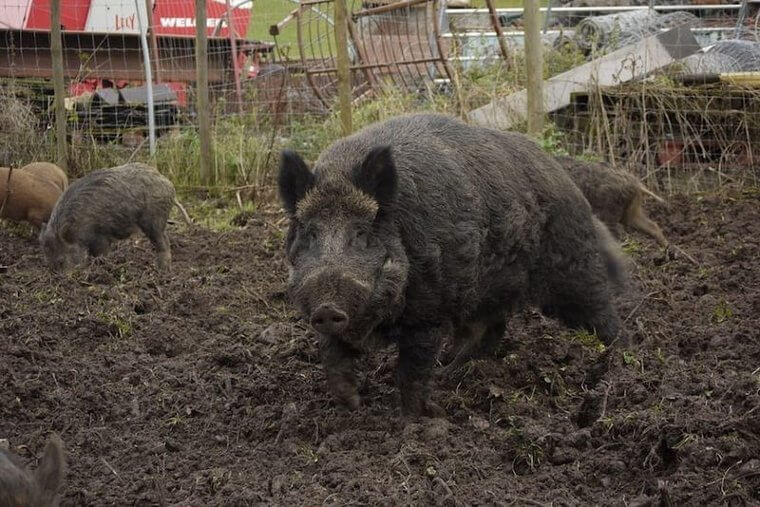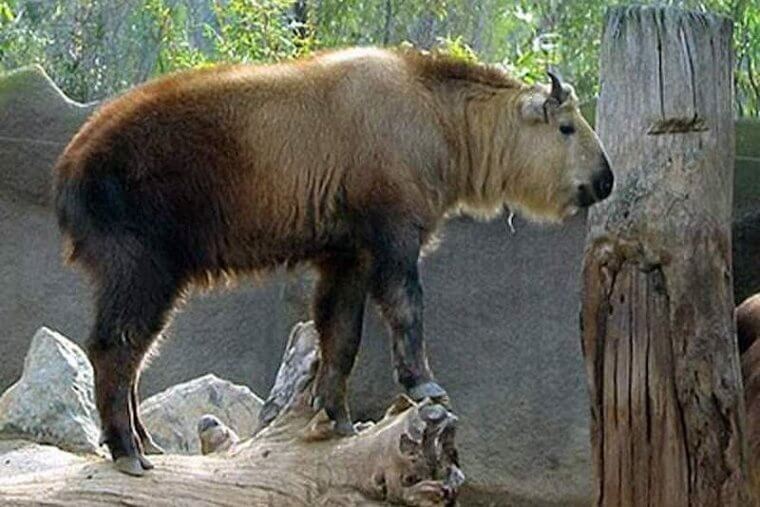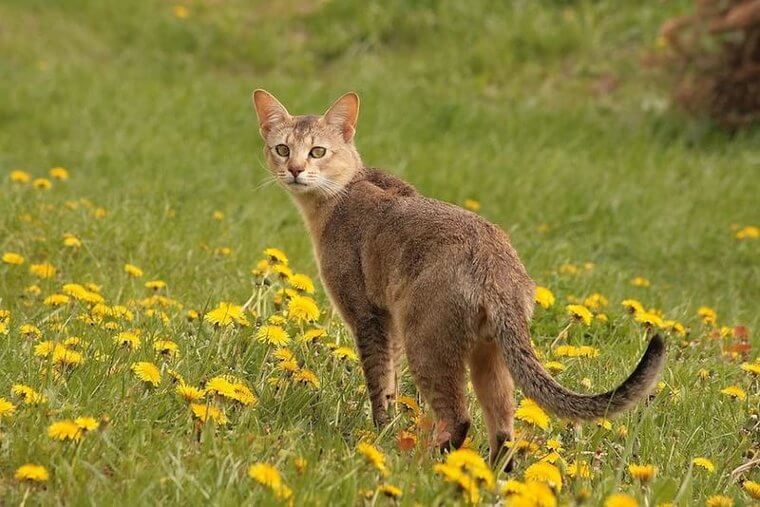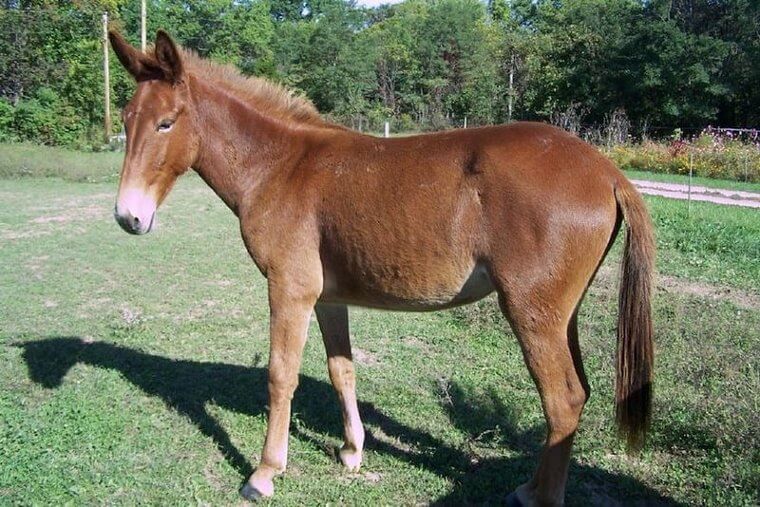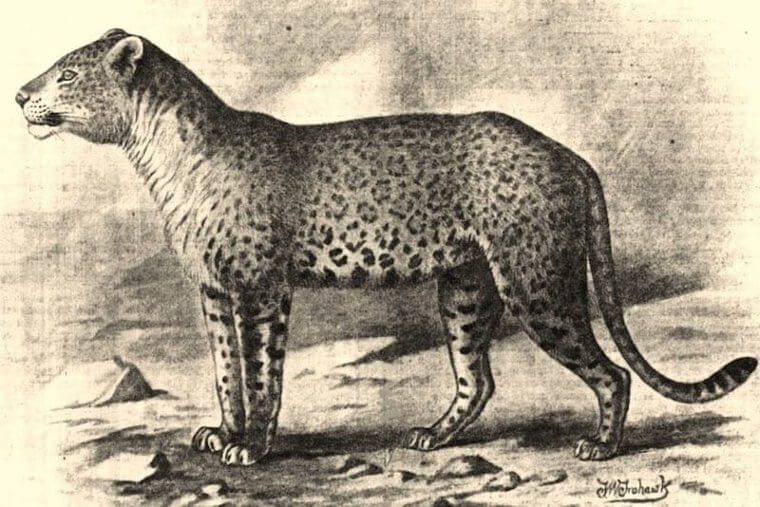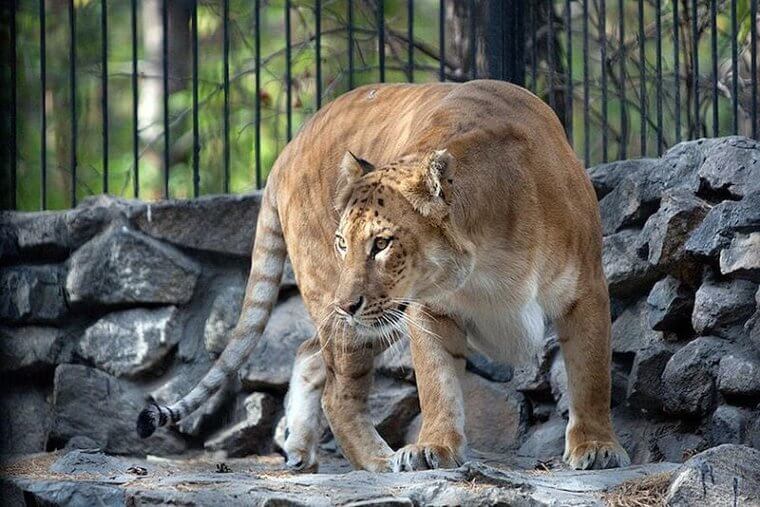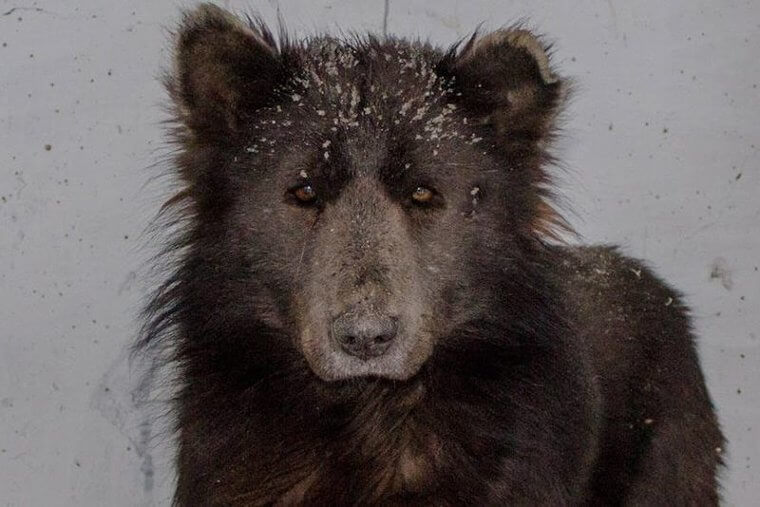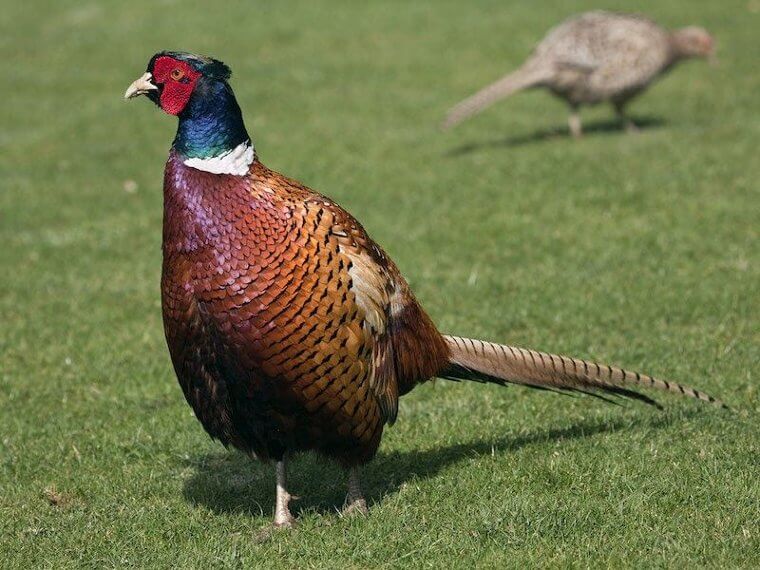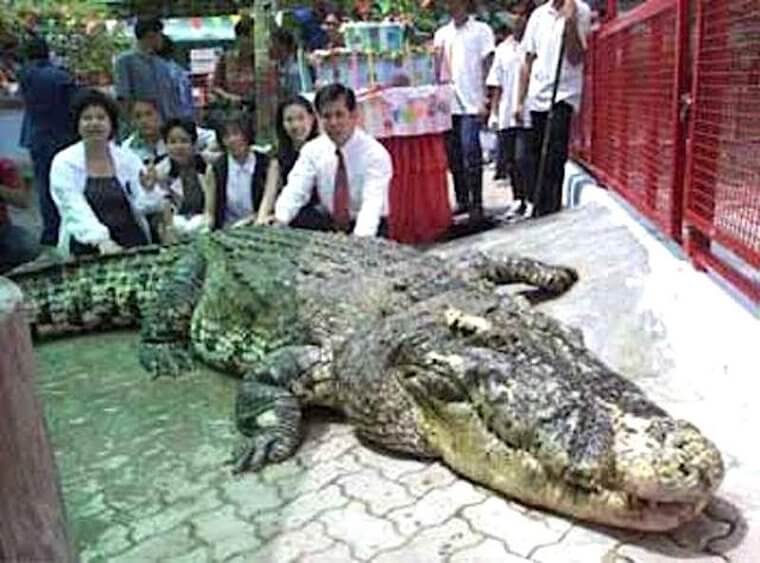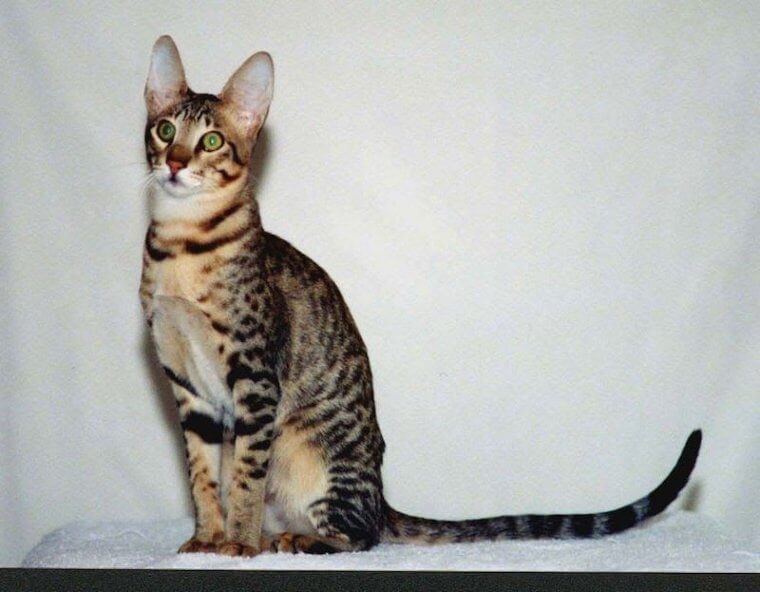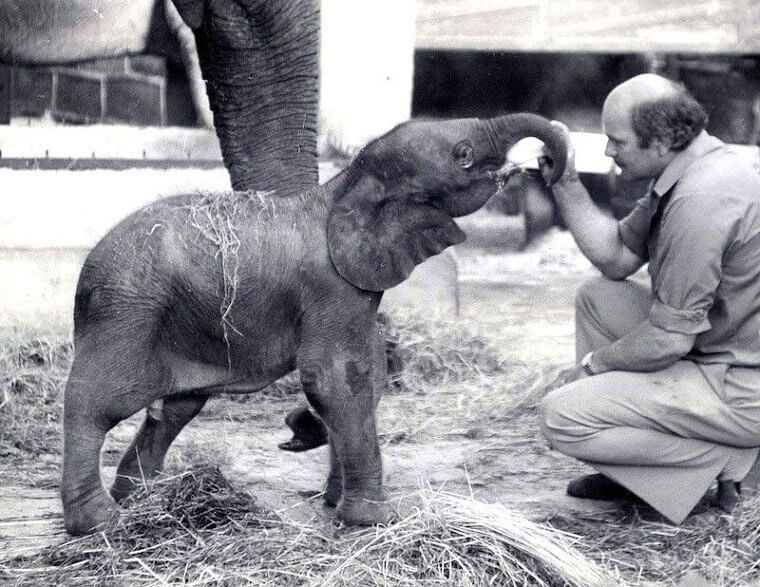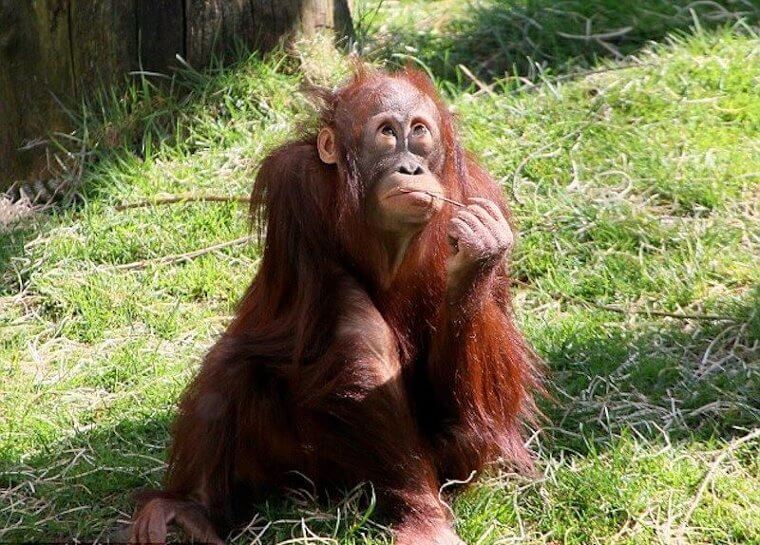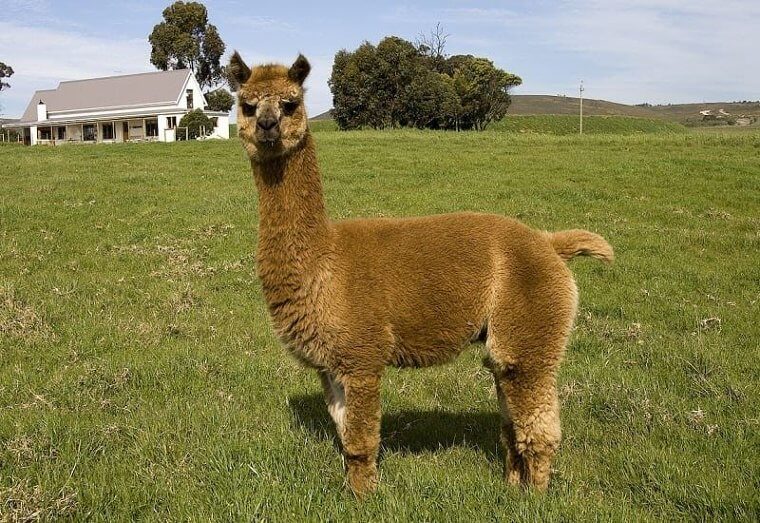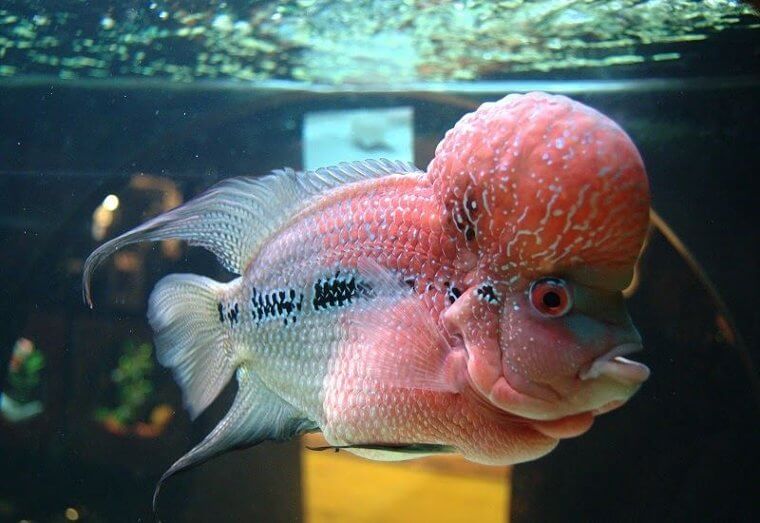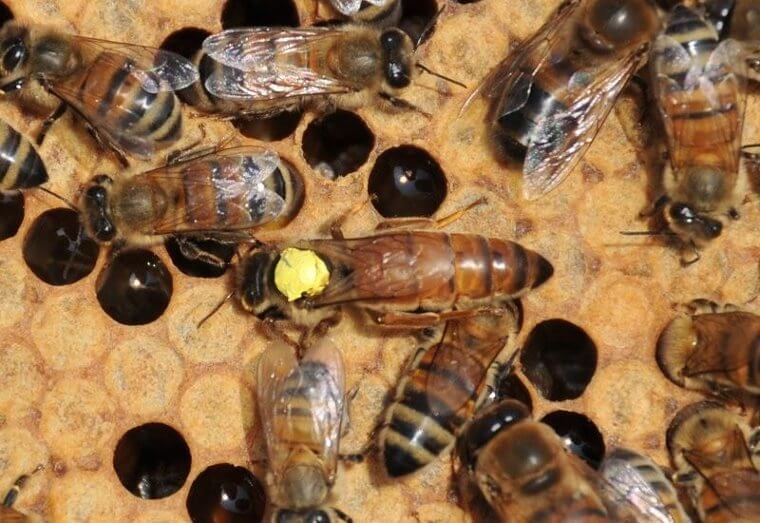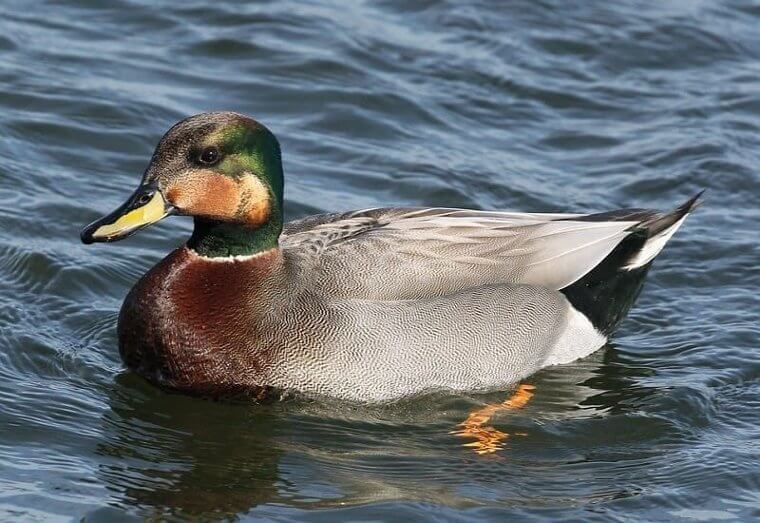Since early childhood, we are taught about different animals and it's generally understood that we know about the majority of them, at least the common ones. However, there is actually a whole group of animals most of us have never even heard of before: hybrids! Read on to learn about these captivating hybrid animals, some of which are bred in captivity while others can be found in nature. Due to their rarity and unique traits, these animals are incredible and inspire us to explore an entirely new world.
Zonkey
The zonkey is the result of a male zebra and a female donkey. When a male donkey and a female zebra mate, they produce the zedonk. Although most such hybrids have occurred in captivity, their natural existence in the wild has also occurred in places where zebras and donkeys live together.
Their torso appearance is a testimony to their relation to donkeys, while the stripes on their legs are clear indicators of their zebra heritage. They tend to behave more like zebras, being more aggressive in nature and equally reckless.
Jaglion
This animal is a combination of a male jaguar and a lioness. This animal is so exotic that one may even assume that the pictures of it have been created in Photoshop. They happen to have amber eyes, a body like a jaguar, and light spots all over the body to give it a unique appearance.
These two hybrids in the pictures above are named Jahzara and Tsunami and are living in the Bear Creek Wildlife Sanctuary of Ontario, Canada.
Caraval
This hybrid is a result of a male caracal cat mating with a female serval cat. This cat appears quite strange because of its disproportionate head, which is pretty small in size compared to the rest of its body.
Its opposite hybrid, a cross between a male serval and a female caracal cat, also exists and is known as a servical. At the Los Angeles Zoo, when the two animals were kept together, several servical kittens were produced accidentally. They had elongated black-tipped ears acquired from the caracal and the spotted body of a serval. They are usually bred to be sold as pets.
Grolar Bear
This giant-sized ‘teddy bear’ is a rare cross between a grizzly bear and a polar bear. This ursid (bear family) hybrid occurs both in captivity and in the wild. This unique hybrid has earned itself another name: the prizzly.
Grolars differ from polar bears in the brown strokes of fur found between their thick, white, fur coats. This makes them appear slightly yellowish in color. Although this animal is a hybrid of a grizzly and polar bear, it mostly acquires the physical traits of the polar bear, although it is slightly smaller in size. It's still big enough that you'd want to avoid it if you saw it in the wild, though!
Beefalo
Like grolar bears, this animal happens to carry two names as well - it's known as either the beefalo or the catallo. This animal is a cow/buffalo hybrid that has been in existence since 1979. These animals are reproduced by the meat industry to meet the ever-growing demand for beef as they are not only pretty large in size but happen to also pack large quantities of meat.
Although they are contributing much to the food supply, these animals are also a hazard to the environment. They consume large quantities of water, no less than eight gallons per day, and also need to consume large qualities of food, which depletes fields.
White Tigers
Is there anything more beautiful and majestic than a snow-white tiger? Well, maybe after reading this tiger's story you'll seriously consider your answer. Kenny the white tiger became famous around the world as the "World's Uglies Tiget" due to his abnormal facial features, but these were the result of generations of inbreeding.
White coloring in tigers never occurs in nature, rather it's the result of selective breeding by humans. Throughout the years more and more inbreeding occurred in order to preserve the gene that makes the tigers white, and it culminated in Kenny and his brother Willie, who was also born with a deformed face.
Leopon
Big cats are animals that have always fascinated people. To come across a hybrid of these cats is even more alluring. The leopon - a cross between a lion and a leopard - is an animal that seems to be fictional.
The leopard-style, spotted-bodied animal possesses the mane of a lion and has a very unique appearance. Although there have been reports of its sightings in countries like Ethiopia and Kenya, scientists have not yet received any official confirmation of their existence in the wild.
Zorse
The name is suggestive enough to understand that this animal is a cross between a horse and a zebra. Based on a quick glance, it can look like just one of its two parent animals, but when closely inspected, you can see that it is neither of the two and actually a hybrid.
In terms of behavior, the zorse can swing either way between its two parent animals. It can be gentle and cordial like a horse or as headstrong as a zebra. Similar to their unpredictable behavior, these animals can have an equally unpredictable appearance. The animals have manes just like both their parent animals, but they can either have stripes like a zebra or the pattern can be splotchy more like a horse.
Tigon
Cross two of the biggest cats in nature and you'll get the tigon as a result. A cross between a male tiger and a female lioness, this hybrid comes into existence when the two animals of entirely different habitats come across each other.
The animal has variation in its hue and can have both tiger and lion fur patterns at the same time. The tigon is as fierce as either of its parents and is nothing close to huggable!
Liger
The liger is the exact opposite of the tigon, coming into existence when a male lion breeds with a female tigress. Since these two animals do not naturally inhabit the same habitats, their offspring are artificially conceived.
This huge animal does appear intimidating - ligers are the biggest cats in the world. Their growth rate is high and they can grow massive in size even compared to both tigers and lions. The picture above is of a liger named Hercules, who is the largest existing cat weighing 490 kilograms (or 940 pounds). That is HUGE!
Hairless Bear
Now, this is the one exception on our list - this is a hairless bear.
Yes, you read that correctly. This is what a bear without its coat of fur looks like. And no, this isn't photoshopped. Now back to our hybrids! Coming up... Wholphins and Geeps!
Ancient Pig
Though extinct, these ancient pigs were known as Entelodonts. They were enormous animals and humans feared them enough to have referred to them as ‘Hell Pigs' as with their immense size and power, they could kill anything in their path (including humans!).
Since these animals are now extinct, farmers have tried to create hybrids by breeding domesticated pigs with wild boars. Their results were similar, but smaller in size, compared to these extinct animals. Hybrid animals are also angry and stubborn in nature.
Geep
This cute little animal is one of the rarest hybrids to occur, as most of them die either as embryos or as stillborns. A cross between a goat and a sheep, a geep displays some characteristics of both its parent animals.
Geeps tend to have fluffy, woolen sheepskin inherited from the sheep, with an elongated face matching that of a goat. Although there have been reports of several geeps existing around the world, they are not commonly seen around.
Wholphin
Though the name sounds like the twisted pronunciation of a toddler for a dolphin, this is actually the name of our hybrid, which happens to be a cross between two species of dolphins. The wholphin is a product of a false killer whale (a type of dolphin) mating with a bottlenose dolphin. This is a rare hybrid to occur despite both its parents sharing the oceans.
There have been reports of wholphin sightings in the wild but per the official records, there exist only two of them in the world, both at Sea Life Park in Hawaii. In terms of their teeth, these offsprings of false killer whales and bottlenose dolphins lose in numbers. The bottlenose has a whopping 88 teeth, the false killer whales 66, and yet the wholphins have only 44 teeth in total.
Savannah
This hybrid is now registered as its own breed of cat with the International Cat Association. Due to the popularity of its cute look, it has gained admiration from cat breeders. This hybrid cat is a cross between a serval and a domestic cat and is usually far more friendly than ordinary domestic cats tend to be.
The savannah is also the world's tallest domestic cat and grows at a fast rate. They're known to have an almost canine-like personality, being extremely loyal to their owners and very attention-seeking.
Wolfdog
The wolfdog is the product of a wolf and a domestic dog cross. They look as adorable as the usual dogs but their behaviors are much more unpredictable. Currently, in the United States alone, there are 300,000 to 500,000 wolfdogs, which is a considerably large population of hybrids.
To get a thicker, fluffier coat on these hybrids, they are often crossed with Siberian Huskies or Alaskan Malamutes. Unlike most other hybrids like ligers, these hybrids are not infertile, therefore they can reproduce among themselves as well.
Dzo
Also known as a yattle, this animal carries great value among Tibetan and Mongolian farmers. It is a cross between a domestic cow and a wild yak, and because of its high value, it is the most common hybrid in Asia.
These hybrids are much bigger than any cow or a yak, and therefore pack a lot more meat and also produce more milk. This is the reason why they are considered so valuable among the farmers who own them.
Coywolf
The cross between a coyote and a wolf does not really appear distinct from any ordinary coyote but trust us, the one pictured below is a hybrid. Coywolves are found in the eastern part of North America and are larger than standard coyotes.
These animals with different shades of brown on their coats happen to possess the behavioral traits of both their parent animals. These hybrids also have different varieties of their own which include the North-Western gray wolf-coyote and the Mexican gray wolf-coyote.
Hinny
This animal gets its name from a female donkey, also known as a Jenny, and a male horse, hence the name combination of Hinny. Their size can vary but in general, these hybrids are smaller than donkeys in size.
Since horses and donkeys happen to have a different number of chromosomes, it is difficult to successfully mate the two to produce a hinny and for this reason, this is an extremely rare hybrid animal. The hinny itself also has an unusual number of chromosomes as a result, and thus also has a hard time breeding.
Cama
A cross between a male camel and a female llama, this animal can only be produced artificially and does not naturally occur in the world. It has the same strength as a camel but the easier and more cooperative disposition of the llama. It also produces more amounts of wool compared to its parent animals.
To this date, there have been only five of them produced in the world, out of which one needs serious discipline training while the other four have reasonably gentle dispositions.
Mulard
Also known as mule ducks, mulards are the products of a cross between Muscovy and Pekin ducks. These birds are sterile and are produced through artificial insemination.
These ducks are mass-produced for their meat in the meat industry. The hybrids are used to prepare a French dish known as foie gras which is a luxury dish comprising of duck or goose liver. It is for this reason that these birds are fairly common in France, and even now outnumber geese in the country when it comes to foie gras production.
Coydog
Their appearance is as furry as a regular domestic dog but their behavior is more inclined towards coyotes. They are among the fertile hybrids who can reproduce both among themselves or other animals of their parent species. They can be found all across the US.
They are known to be very intelligent animals as well as very adaptive. This adaptive nature of theirs allows them to blend in with other animals. These hybrids are known to have very good temperaments.
Mule
This bird is an intriguing hybrid between a canary and a European goldfinch and has been artificially bred since the Victorian era when they were famed as songbirds.
They are famous for singing the best of all birdsongs and for this reason, served as cage birds back in the day. Now not as common as they were in that era, still they are bred and kept by aviculturists. These birds, like so many other hybrids, are sterile despite still being bred for captivity.
Blacktip Shark
These hybrids are found in the northern and eastern oceans of Australia and are a cross between Australian blacktip and Common blacktip sharks. There is no human interference in the production of this particular hybrid; they occur naturally in the wild and are a recent discovery among marine biologists.
There is still much to learn about these animals and therefore much testing and examination are required, but the blacktip shark is vulnerable to overhunting by humans as its fins are a choice for the production of shark-fin soup.
Narluga
These very benign-looking marine mammals are a cross between beluga and narwhal whales. In the ’80s, a skull of a narluga washed up on the shore of Greenland. Upon examination, it was found that this whale had the physical traits of both its parent animals.
That initial find was the first official discovery of these animals. Since they originate from the same family of whales and therefore occur in nature naturally, this crossbreeding is neither rare nor surprising. There is still much to learn about this interesting hybrid.
Hybrid Iguana
Found in and indigenous to the Galapagos Islands, hybrid iguanas are a combination of male marine iguanas and female land iguanas. They can be distinctly recognized due to white speckles near their heads and darker shades all over their bodies.
They are conceived naturally and about 20 of them have been discovered since 2003. Because they are the offspring of marine and land iguanas, they can adapt to both environments; they can dive into the seas to find seaweed to eat, while at the same time their claws allow them to climb cacti for food.
Dingo-Dog
Hybrid dingo-dogs are a combination of dingos and domesticated dogs. They have diverse variants in terms of size, shape, and color; each dog is unique in its appearance but typically a variation on a ginger body with white paws.
Dingo-dogs exhibit the hunting patterns of true dingos and are apex predators in their habitat in Australia. The population of true dingos in Australia has actually been found to be decreasing in their habitat while the hybrid cross-population has been found to be on the rise, threatening the existence of the pure dingo.
Killer Bee
Although a very common name and a widely-known insect, many do not have any clue that this little insect is actually a cross between African and European honey bees. These bees are very tenacious and can stand extreme tropical conditions such as those in the Amazon rain forests of Brazil.
They are highly adaptable and can easily adjust to hot and humid environments. These bees are also known to be very aggressive, as their name would suggest, and can attack in swarms with such intensity that at times they may even cause death to humans. It is highly suggested to stay away from their hives and habitats.
Zubron
The hybrid between a cow and a European bison is what we call a zubron. Bred in Poland for the first time in 1969, it was given its name in a naming contest organized by a Polish magazine.
These hybrids are extremely large and bulky and the males of the breed can weigh as much as 2600 pounds. Their dark and shaggy coats make them physically resemble their parent animal, the bison. They were produced to replace cows but the project was declared a misstep.
Blynx
When a bobcat mates with a Canadian lynx, the result is a blynx! Initially, it was thought that these animals were just fiction, but several sightings of the hybrids convinced scientists that not only are these animals a regular occurrence but that they are also fertile.
The blynx is the same size as its parents; it acquires the black-tipped ears from the lynx while its face more resembles a bobcat. It has either a very short tail or completely lacks one...
Blood Parrot Cichlid
In the mid-'80s, this hybrid was created by crossing Midas cichlids and Redhead cichlids in Taiwan. Its breeding gave rise to a huge controversy because of several negative genetic defects it ended up having, namely its mouth.
It has a beak-like mouth that does not close properly and makes it difficult to feed; this became the reason behind its name. This fish is normally of orange color but does exist in yellow and red colors as well.
Pumapard
The breeding of a puma and a leopard produces an offspring called a pumapard. The pumapard tends not to grow to more than half the size of either of its parents and in fact, exhibits dwarfism- the exact opposite of the other cat hybrid on this list- the liger.
The pumapard came into existence in the late 19th century when they were first bred in Chicago. It did not take much time for them to become a status symbol among the wealthy throughout the world. Their bodies are long like those of pumas and they have spots (called rosettes) which they acquire from leopards (though these spots are much faded compared to their parent).
Zetland
Male zebras again can find another mating match for themselves in the form of female shetland ponies to produce hybrids known as zetlands. Given the number of hybrids zebras can create, they surely have a very high fertility match with other species in their family.
There is another term, zebroid, which engulfs all the hybrids produced by crossing zebras with other animals and this includes our zetland. Zetlands have short, squat legs acquired from the pony while the stripes are inherited by the zebra (though they are hard to make out).
Bengal Cat
A Bengal cat is created through a process of cautious and precise selective breeding between hybrids of domestic cats and wild Asian leopard cats, which are fairly common throughout Asia. As the name suggests, these cats originated in Bengal, India.
These animals tend to be fascinating pets for the reason that they have gentle calm behavior acquired from the domestic cats while at the same time their long, spotted bodies make them resemble their cousins from the wild.
Iron Age Pig
This animal was produced as a result of back-breeding in England. This simply means this animal was created to resemble an extinct species of pigs.
This animal is the offspring of a female domesticated pig, or sow, and a wild boar. This breeding results in the hybrid, which is a considerably large-sized animal and is supposed to resemble the pigs of old times as shown in the artworks of those periods. These pigs are produced for the meat industry, mostly in Europe.
Yakalo
Yaks can also mate with American bison to produce yakalos as their offspring. These two species do not interact with each other in the wild, therefore it is clear that yakalos do not occur naturally. In fact, these animals were produced by scientists in the 1920s as a part of an experimental project regarding hybridization.
These animals were produced using either pure bison or, for the most part, using beefalos (which we learned about earlier!). The heads of these animals resemble those of bison while their remaining body has a mix of bison and yak appearance. Unfortunately, the experiments surrounding these hybrids were not very successful and were abandoned.
Chausie
A chausie is a hybrid of a domestic cat and a jungle cat and is also known as felis chaus. This alternate name became the origin of the name "chausie" given to this hybrid. The jungle cat is native to the Nile River Delta so the chausie can trace its roots to the ancient Egyptian civilization. These cats were greatly respected in those times, enough to even be mummified.
The domestic cats and the jungle cats may have interacted back then to produce chausies, but in modern times, these two animals were crossed to produce hybrids during the 1990s under a dedicated program.
Mule
Mules (not the bird) are a cross between a male donkey and a female horse and demonstrate the best traits of both the horse and the donkey. These animals are much more tolerant than a horse and also have more stamina, while at the same time are far less stubborn than a donkey and are much more intelligent.
The size of the mules varies and is basically dependent on the size of the female horse that is mated with the male donkey. Male mules are always sterile while the female mules at times can conceive.
Jagupard
When a male jaguar and a female leopard mix their genetic material, the result is a jagupard. Given that both the parent animals resemble each other to a great extent, their union produces this amazingly beautiful animal. Both the parent animals happen to have rosettes, which are their trademark, although these rosettes are slightly different from each other.
Leopards are indigenous to America while jaguars are African animals, therefore it is clear that these animals do not share a habitat and thus their hybrids are not found naturally. These hybrids are produced in the zoos of Austria and the US.
Liliger
A liliger is a hybrid within a hybrid! This animal comes into existence when a male lion mates with a female ligeress - the female version of the liger which we learned about previously.
The first of this second-generation hybrid was born in the Munich Zoo of Germany in 1943. In more recent times, liliger cubs were born in the Moscow Zoo in Russia. The picture above is of one of those cubs. Although their ligeress mother was stripped, these cubs display spots on their bodies.
Russian Bear-Dog
This cross sounds a bit absurd and is probably more myth than fact, but we still have this name on the list because the pictures of this animal went viral. It was said that it is a cross between a bear and a dog, or a wolf. Looking at the animal it does give that impression with its canine body and bear-like face.
The animal shelter that took this animal named it Chow Chow. Upon inspecting it, it was understood that the animal is a result of a canine cross with some long-nosed, stray dog. Given the conditions this animal was in, it developed a bad temperament. This attitude combined with its appearance probably led to the Bear-Dog myth surrounding it.
Hybrid Pheasant
Although fairly common and are generally thought to be just another ordinary bird, pheasants have hybrids among them too. The hybrid pheasants are a cross between ringneck pheasants and reeves pheasants and are typically viewed as game birds for hunting and eating. These hybrids can occur naturally or with the help of human intervention.
Hybrid pheasants are probably the birds the hunters in old movies would be shown to hunt while discussing their business matters. It's said they taste just like chicken- try one for yourself!
Hybrid Crocodile
Yai is the name of a hybrid crocodile who is a cross between a saltwater crocodile and a freshwater Siamese crocodile. This crossbreeding happened only because the two-parent crocodiles were kept together in a zoo- it would not naturally occur in the wild as the two types of crocodiles have different habitats.
The result of their union was a 20-foot long colossal animal weighing 1,134 kilos (2,500 pounds)- certainly not something you'd want to come across yourself!
Serengeti
Yet again we have another cat hybrid on our list. This cat is again a second-generation hybrid and is a cross between the Bengal cat we explored earlier, and an Oriental shorthair cat.
Since this particular hybrid is recognized by the International Cat Association, its breeding has to be conducted per the ethical code of conduct. Although this cat appears wild like its predecessor the Bengal, it is a domestic animal born from two domestic cats and is kept in homes.
African/Asian Elephant
Born in 1978, Motty the elephant was born a hybrid of a male African elephant and a female Asian elephant and is apparently the only one of its kind. Sadly, Moty died at the age of only 12 days.
Its death was nothing to do with its hybrid genes, but rather an infection that occurred in its umbilical cord stump. Realizing that Motty was an exceptional animal and probably the only one of its kind, the Natural History Museum in London preserved its body and has since kept it on display.
Orangutan Hybrid
This hybrid is the result of the genetic shuffling of a Bornean and Sumatran Orangutan. These hybrids are also referred to as cocktail orangutans, possibly because the word cocktail is simply used as a synonym for a mix or hybrid.
If you'd like to see these cocktail orangutans, best to schedule a visit to a zoo since these animals have always been bred in captivity- you won't find them in the wild. Their numbers in captivity have decreased as well, as there's been a stop put on their breeding.
Huarizo
The huarizo is a mix of two very similar-looking animals: the llama and the alpaca. This hybrid is found in several parts of the world but is most common in South America.
It is believed that huarizos naturally occurring in the wild are sterile, and because of this, there seems not much opportunity for their species to thrive naturally. In order to see this hybrid animal thrive, human intervention is required for their prosperity. Genetic modifications can improve the fertility rate of these hybrids.
Flowerhorn Cichlid
Once again another cichlid that is a result of humans playing with the genetic makeup of animals. While various cichlids were kept together, the result of their breeding came in the flowerhorn cichlid - a hybrid.
Initially constrained in terms of their habitat in captivity, people eventually started releasing them in the wild where they have now attained a status of pests in many countries such as Singapore. Their quick breeding leads them to multiply in numbers very quickly and become hazards to the environment. It is because of these issues that these animals are not allowed in Australia.
Buckfast Bee
About a century back, a monk from the Buckfast Abbey monastery got curious and decided to experiment with bees. The result of that experimentation was a hybrid form of bees we now know as Buckfast bees, and are a hybrid of many subspecies of bees.
These bees were born out of a need to produce bees that would be resistant to a disease that had been sweeping and destroying bee populations. In order to tackle this problem, the monk drew a table listing bees with required hardy traits and characteristics for his planned breeding program and bred them to eventually produce the Buckfast bee.
Clymene Dolphin
Another dolphin hybrid is the Clymene dolphin. This hybrid was only discovered in the mid-1800s, probably because its appearance is hard to distinguish it from one of its parents, spinner dolphins, and striped dolphins.
This hybrid is very similar to spinner dolphins when observed from a distance, but upon closer examination, there are some obvious differences that can be clearly seen. These dolphins in comparison to spinner dolphins have a shorter beak and a triangular dorsal fin, which distinguish them from the other species of dolphins.
Brewer’s Duck
The brewer's duck is a cross between a mallard and a gadwall. It has dark feathers at the front and green coloration on its head and appears very similar to its mallard parent, though it's definitely the friendlier-looking quacker.
Though mallards and gadwalls mate very commonly in the wild, their hybrids are not very commonly found. If you want to find one, you'll have to seek it out for yourself; you might get lucky if you scour the ponds and rivers of the Lonestar state - Texas, USA.

